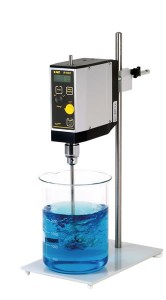Dispersion in the Lab: Sometimes an Overhead Stirrer is All You Really Need
A lab mixer can consist of something as simple as a magnetic stir bar at the bottom of a beaker sitting on a stir plate. This simple stirring option is often adequate to achieve ordinary laboratory mixing tasks. But other mixing tasks may require more sophisticated blending/homogenizing technology.
 These more challenging tasks — perhaps involving immiscible ingredients, which require emulsification — are best performed using an overhead stirrer. Some powders resist blending into liquid. They may clump, form aggregates, or other artifacts, such as “fish eyes,” rather than dispersing thoroughly. An overhead stirrer, which uses carefully designed rotor-stator technology and extremely rapid spinning, excels at the blending of challenging ingredients.
These more challenging tasks — perhaps involving immiscible ingredients, which require emulsification — are best performed using an overhead stirrer. Some powders resist blending into liquid. They may clump, form aggregates, or other artifacts, such as “fish eyes,” rather than dispersing thoroughly. An overhead stirrer, which uses carefully designed rotor-stator technology and extremely rapid spinning, excels at the blending of challenging ingredients.
Overhead stirrers are better suited for tasks that require thorough, rapid mixing. When complete dispersion of challenging ingredients is the goal, it may be advisable to use an overhead stirrer rather than relying on a simple magnetic stirrer. If the rotor-stator apparatus features variable speed control, so much the better.
Mixing and Dispersion are Fundamental Human Activities
For millennia, humans have grasped the potential benefits of thorough mixing. Archeological discoveries indicate that the concept of a grinding, mixing device (the pestle), in concert with a mixing bowl (the mortar), was devised many tens of thousands of years ago.
And no wonder. Mixing is an inherently human activity; central to the production of everything from foods (think sauces, marinades, and spice blends), to ointments and pastes used as cosmetics, to the preparation of medicinal ointments, potions, and other treatments. The crushing/grinding activity of the pestle serves to reduce particle size, while its stirring action helps blend disparate ingredients.
Modern Technology
In the modern age, mixing in the laboratory tends to be a far more sophisticated, less labor intensive activity. We’ve traded arm strength and patience for the convenience of well-engineered machinery powered by electricity. These handy machines come in many shapes and sizes, but all are capable of rapid, thorough particle size reduction and seamless mixing of various ingredients.
The ancient mortar and pestle is inherently inefficient. Modern homogenizing equipment vastly improves on this ancient technology. Today’s machines are capable of speeding up the dispersion of challenging ingredients, such as dry powders, which must be incorporated into liquids, and improving the efficiency and thoroughness of the blending (homogenization) process.
Dispersion refers to a system in which particles of one material are dispersed in a continuous phase of another material. In practical terms, this typically involves dispersing finely ground dry powders into liquid media such as water or other solvents, or even lipids such as oils. To achieve true dispersion, relatively uniformly sized particles must be evenly distributed throughout the liquid phase. And that requires thorough mixing.
